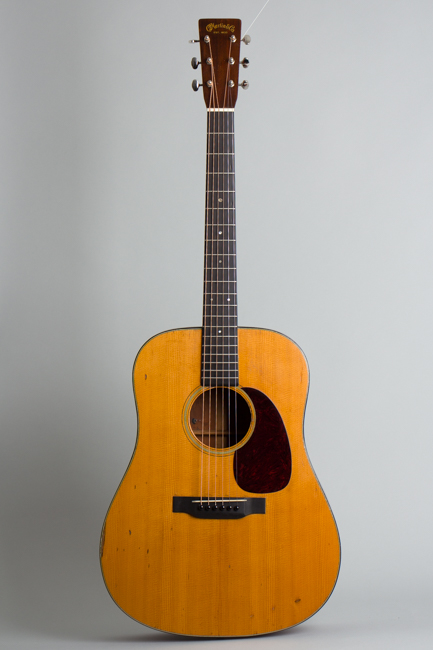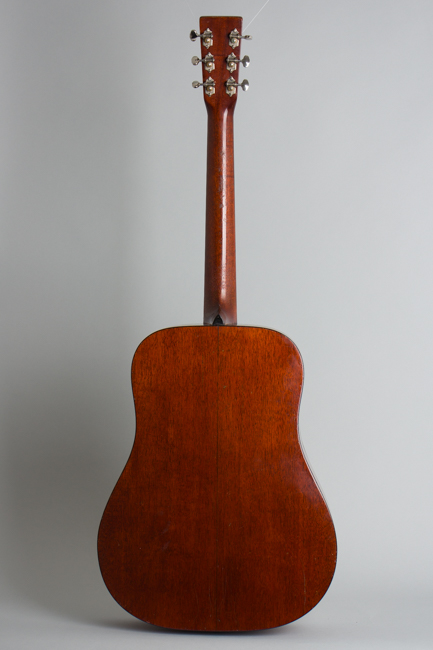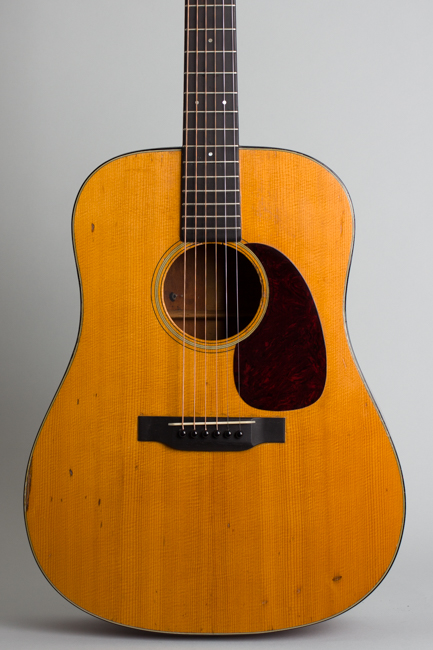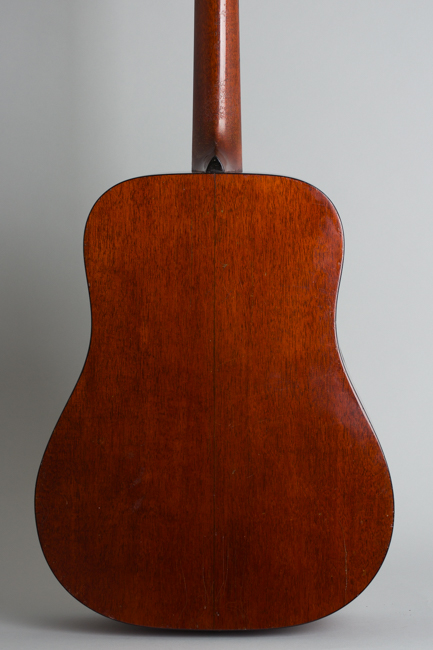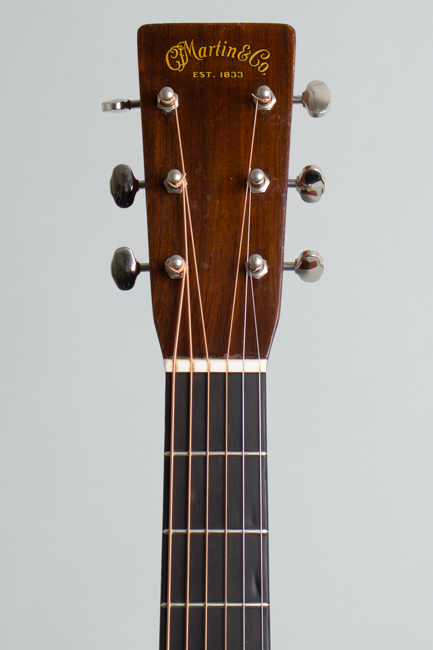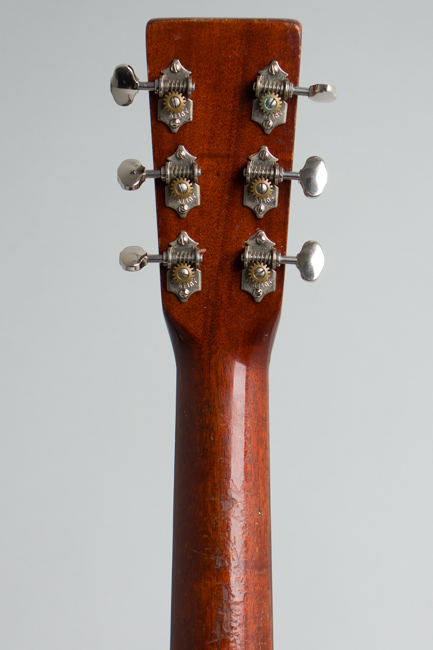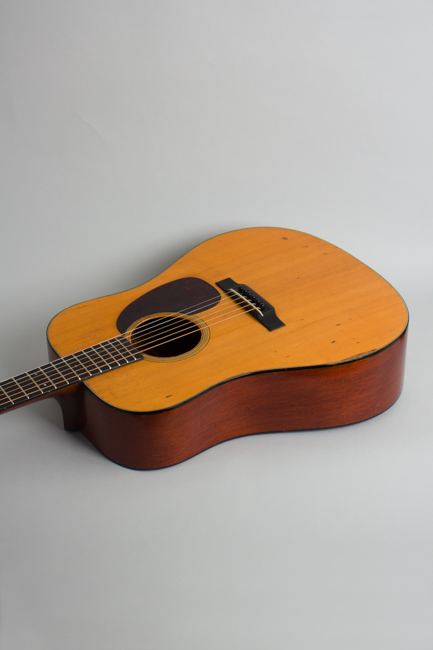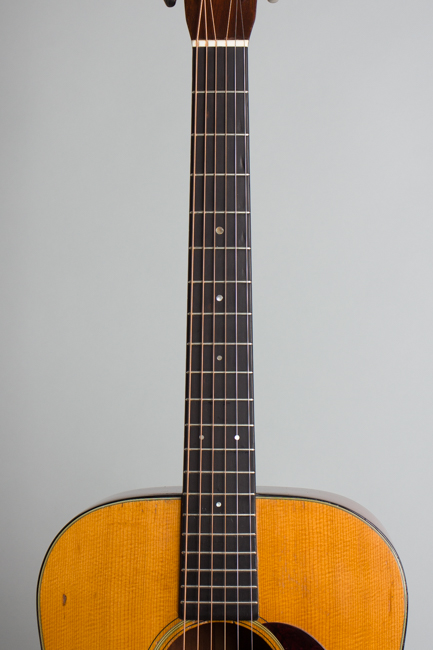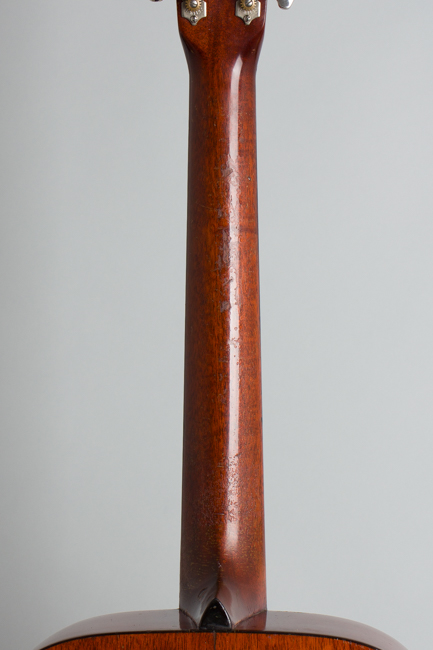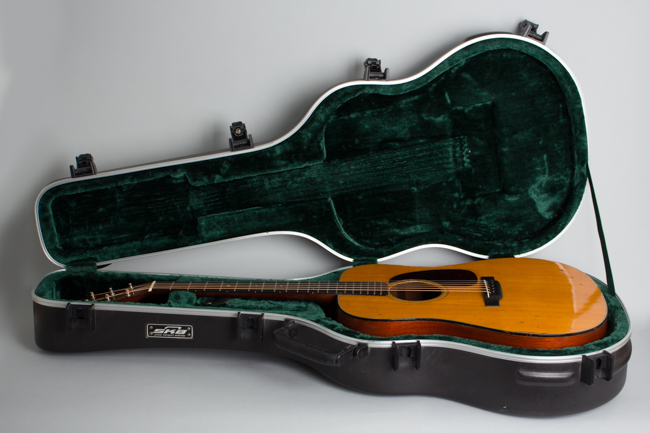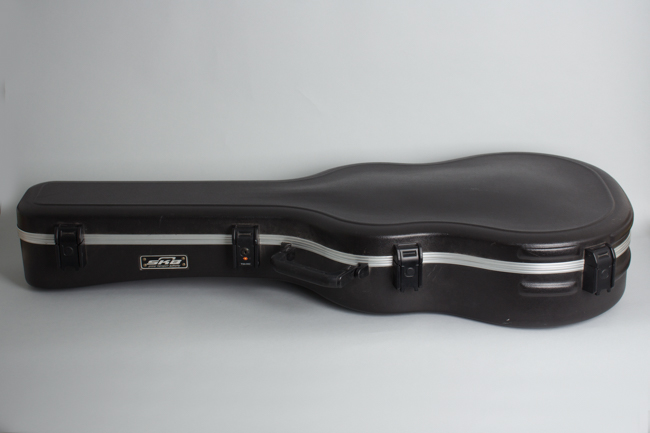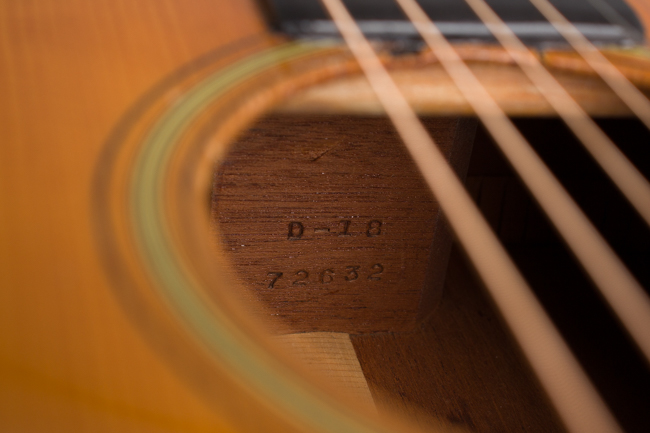C. F. Martin D-18 Flat Top Acoustic Guitar (1939)
C. F. Martin D-18 Model Flat Top Acoustic Guitar (1939), made in Nazareth, PA, serial # 72632, natural lacquer finish, mahogany back sides and neck, spruce top, ebony fingerboard and bridge, molded plastic hard shell case.
This is a solid and great sounding player's example of a guitar that has long been the standard by which all others are judged; the 1939 Martin D-18. This is a played in original 14-fret mahogany Dreadnought that has seen some work over the decades but remains in excellent playing condition and offers the expected fantastic sound. The power and depth of a Dreadnought combines with the sweetness, sparkle, and singing character of the best pre-WWII mahogany Martins in a magical mix, making this an exceptionally versatile flat-top guitar suited to practically any musical situation.
This D-18 shows the classic pre-war features of the model. The back and sides are Honduras mahogany and the top is nicely grained Appalachian spruce, bound on the edge with tortoise celluloid. The ebony belly bridge has a canted bone saddle. The neck is mahogany with an unbound ebony fingerboard discreetly inlaid with small mixed-size pearl dots. The peghead is faced in Brazilian rosewood with the gold "C.F. Martin & C." decal at the top. The neck profile is round backed but with the slightest hint of a "V" profile in the way the sides bear away from the center as it moves towards the nut, which is still the larger 1 3/4' width Martin slimmed down soon after this example was built. The original tuners were open back individual Grover units with "butterbean" metal buttons, replaced with correct style repros here.
A large percentage of Country and Western performers of the 1930s, '40s and '50s found the Martin Dreadnought the best instrument for their situation. In 1940 the price of a new D-18 was $65 (without case), a sizable expense for many Americans at the time. They sold decently by contemporary standards, with 475 shipped that year, at that point the production peak. By the 1950s Martin was building two or three times that amount every year; pre-war examples were far scarcer even then. Today over 80 years later finding a 1939 example even as well preserved as this is a fairly rare occurrence.
In the minds of most acoustic guitar players, collectors, and historians, very few instruments approach the pre-war Martin Dreadnought in terms of sound and historical importance. Compared to all that's come down the pike since, this is still one of the finest performing or recording guitars imaginable. While the rosewood D-28 is optimized for power and bass response, the D-18 is often a more versatile instrument combining the mellow depth of the Dreadnought with a crisp, slightly dry mahogany ring. This is a well used, great sounding pre-war example, a true veteran ready for many more years of service.
Overall length is 41 in. (104.1 cm.), 15 3/4 in. (40 cm.) wide at lower bout, and 4 15/16 in. (12.5 cm.) in depth at side, taken at the end block. Scale length is 25 1/2 in. (648 mm.). Width of nut is 1 3/4 in. (44 mm.).
While certainly not pristine this is a relatively well preserved and still largely original Pre-war guitar overall, showing some typical wear and mostly older repair. The body and back of the neck show an old clear lacquer overspray done LONG ago; this is very thin and a lot of the wear has happened since. There is less pick wear to the top than many, what there is being isolated on the soundhole ring and area below the fingerboard extension. There are a number of old case lid dings scattered around the top; it looks like the lid hit it more than once. The top armwear spot is worn through to the wood just at the edge. The back and sides have some broad checking and scuffed spots but less "cowboy" buckle wear to the back than some. The back of the neck has capo wear along the spine and some odd reactive finish roughness behind the 10-11th fret area, likely the result of reaction with the neck rest in a case.
The repair history likely encompasses many decades. On careful examination it appears the top has been off and back on the guitar; there is visible disturbance along the external binding line and glue ooze around some kerfing spots. The lovely scalloped bracing appears original with no damage but there are some visible reglued spots there as well. The bridgeplate is the correct original style small maple piece but this may have been replaced long ago. A T.J. Thompson replica bridge is installed, with visible wear around the perimeter and some small spruce chip-off alo0ng the front edge from the original lifting. The pickguard is a correct style There is a visible grain split under the fingerboard emerging on the top of the soundhole ring; a thin spruce patch has been added between the forward brace and the neck block. Another small chip is off the rim just above this.
There are far fewer cracks to the guitar than many vintage Dreadnoughts. The top is crack free except for the small area under the fingerboard noted above. The back has a visibly sealed grain split off the back edge on the lower bass bout and a deep check above the neck block on the upper treble bout that does not go all the way through the wood. The sides likewise have several deep checked lines that do not extend through to the interior.
The neck has been visibly reset, solidly but not as neatly as some and it appears more recently than some of the other work. The frets appear original or possible an old refret with the correct wire; they have been lightly crowned down in either case. The bone nut appears original with a small shim added. There are some shallow fingerboard divots in the first position. The tuners are recent Waverly-branded open-back Grover repros s with metal buttons. There is a visible filled strap button hole on the treble side of the heel.
This D-18 is an excellent playing example, set up with a medium/low action. In any playing situation the sound of these lightly built pre-war Dreadnoughts is truly inspiring, and this one certainly does not disappoint. Perhaps not a collector's piece this remains an extremely fine player's D-18, this guitar has been a working instrument for over 85 years now. With some care it will still be providing wonderful sounds for many decades to come Overall Very Good + Condition.
This is a solid and great sounding player's example of a guitar that has long been the standard by which all others are judged; the 1939 Martin D-18. This is a played in original 14-fret mahogany Dreadnought that has seen some work over the decades but remains in excellent playing condition and offers the expected fantastic sound. The power and depth of a Dreadnought combines with the sweetness, sparkle, and singing character of the best pre-WWII mahogany Martins in a magical mix, making this an exceptionally versatile flat-top guitar suited to practically any musical situation.
This D-18 shows the classic pre-war features of the model. The back and sides are Honduras mahogany and the top is nicely grained Appalachian spruce, bound on the edge with tortoise celluloid. The ebony belly bridge has a canted bone saddle. The neck is mahogany with an unbound ebony fingerboard discreetly inlaid with small mixed-size pearl dots. The peghead is faced in Brazilian rosewood with the gold "C.F. Martin & C." decal at the top. The neck profile is round backed but with the slightest hint of a "V" profile in the way the sides bear away from the center as it moves towards the nut, which is still the larger 1 3/4' width Martin slimmed down soon after this example was built. The original tuners were open back individual Grover units with "butterbean" metal buttons, replaced with correct style repros here.
A large percentage of Country and Western performers of the 1930s, '40s and '50s found the Martin Dreadnought the best instrument for their situation. In 1940 the price of a new D-18 was $65 (without case), a sizable expense for many Americans at the time. They sold decently by contemporary standards, with 475 shipped that year, at that point the production peak. By the 1950s Martin was building two or three times that amount every year; pre-war examples were far scarcer even then. Today over 80 years later finding a 1939 example even as well preserved as this is a fairly rare occurrence.
In the minds of most acoustic guitar players, collectors, and historians, very few instruments approach the pre-war Martin Dreadnought in terms of sound and historical importance. Compared to all that's come down the pike since, this is still one of the finest performing or recording guitars imaginable. While the rosewood D-28 is optimized for power and bass response, the D-18 is often a more versatile instrument combining the mellow depth of the Dreadnought with a crisp, slightly dry mahogany ring. This is a well used, great sounding pre-war example, a true veteran ready for many more years of service.
Overall length is 41 in. (104.1 cm.), 15 3/4 in. (40 cm.) wide at lower bout, and 4 15/16 in. (12.5 cm.) in depth at side, taken at the end block. Scale length is 25 1/2 in. (648 mm.). Width of nut is 1 3/4 in. (44 mm.).
While certainly not pristine this is a relatively well preserved and still largely original Pre-war guitar overall, showing some typical wear and mostly older repair. The body and back of the neck show an old clear lacquer overspray done LONG ago; this is very thin and a lot of the wear has happened since. There is less pick wear to the top than many, what there is being isolated on the soundhole ring and area below the fingerboard extension. There are a number of old case lid dings scattered around the top; it looks like the lid hit it more than once. The top armwear spot is worn through to the wood just at the edge. The back and sides have some broad checking and scuffed spots but less "cowboy" buckle wear to the back than some. The back of the neck has capo wear along the spine and some odd reactive finish roughness behind the 10-11th fret area, likely the result of reaction with the neck rest in a case.
The repair history likely encompasses many decades. On careful examination it appears the top has been off and back on the guitar; there is visible disturbance along the external binding line and glue ooze around some kerfing spots. The lovely scalloped bracing appears original with no damage but there are some visible reglued spots there as well. The bridgeplate is the correct original style small maple piece but this may have been replaced long ago. A T.J. Thompson replica bridge is installed, with visible wear around the perimeter and some small spruce chip-off alo0ng the front edge from the original lifting. The pickguard is a correct style There is a visible grain split under the fingerboard emerging on the top of the soundhole ring; a thin spruce patch has been added between the forward brace and the neck block. Another small chip is off the rim just above this.
There are far fewer cracks to the guitar than many vintage Dreadnoughts. The top is crack free except for the small area under the fingerboard noted above. The back has a visibly sealed grain split off the back edge on the lower bass bout and a deep check above the neck block on the upper treble bout that does not go all the way through the wood. The sides likewise have several deep checked lines that do not extend through to the interior.
The neck has been visibly reset, solidly but not as neatly as some and it appears more recently than some of the other work. The frets appear original or possible an old refret with the correct wire; they have been lightly crowned down in either case. The bone nut appears original with a small shim added. There are some shallow fingerboard divots in the first position. The tuners are recent Waverly-branded open-back Grover repros s with metal buttons. There is a visible filled strap button hole on the treble side of the heel.
This D-18 is an excellent playing example, set up with a medium/low action. In any playing situation the sound of these lightly built pre-war Dreadnoughts is truly inspiring, and this one certainly does not disappoint. Perhaps not a collector's piece this remains an extremely fine player's D-18, this guitar has been a working instrument for over 85 years now. With some care it will still be providing wonderful sounds for many decades to come Overall Very Good + Condition.
